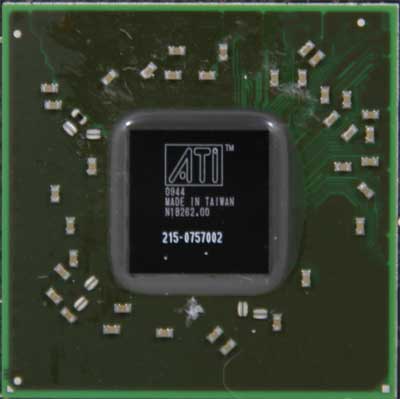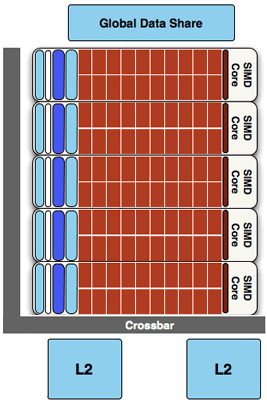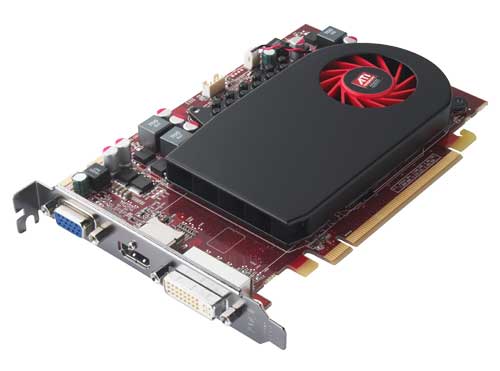AMD's Radeon HD 5670: Sub-$100 DirectX 11 Starts Today
by Ryan Smith on January 14, 2010 12:00 AM EST- Posted in
- GPUs
After a holiday break, AMD’s staggered launch of the Evergreen family picks back up today with the launch of the Radeon HD 5670. The 5670 marks the desktop launch of Redwood, the 3rd chip in the Evergreen family, designed to fit in below the Juniper chip that powers the Radeon HD 5700 series.
| ATI Radeon HD 5750 | ATI Radeon HD 4850 | ATI Radeon HD 4770 | ATI Radeon HD 5670 | ATI Radeon HD 4670 | |
| Stream Processors | 720 | 800 | 640 | 400 | 320 |
| Texture Units | 36 | 40 | 32 | 20 | 32 |
| ROPs | 16 | 16 | 16 | 8 | 8 |
| Core Clock | 700MHz | 625MHz | 750MHz | 775MHz | 750MHz |
| Memory Clock | 1.15GHz (4.6GHz data rate) GDDR5 | 993MHz (1986MHz data rate) GDDR3 | 800MHz (3200MHz data rate) GDDR5 | 1000MHz (4000MHz data rate) GDDR5 | 1000MHz (2000MHz data rate) GDDR3 |
| Memory Bus Width | 128-bit | 256-bit | 128-bit | 128-bit | 128-bit |
| Frame Buffer | 1GB / 512MB | 1GB / 512MB | 512MB | 1GB / 512MB | 1GB / 512MB |
| Transistor Count | 1.04B | 956M | 826M | 627M | 514M |
| TDP | 86W | 110W | 80W | 61W | 59W |
| Manufacturing Process | TSMC 40nm | TSMC 55nm | TSMC 40nm | TSMC 40nm | TSMC 55nm |
| Price Point | $129 - $149 | $99-$129 | $129 | $99 / $119 | $60-$90 |
AMD has been relatively straightforward in designing the Evergreen family. Each chip is half of its bigger brother. This means that the Redwood chip and the 5670 is in most ways half of a Juniper/5770: half the SIMDs (400), half the ROPs (8), half the texture units (20), etc. The core clocks are also slightly changed compared to the 5870 and 5770; here we have a core clock of 775MHz instead of 850MHz as found on those cards. So on paper, the 5670 is going to be slightly less than half of a 5770 in performance.
The one hardware unit that hasn’t been halved is the memory bus – we still have the same 128-bit GDDR5 memory bus as found on the 5770, but here it’s clocked at a 4GHz data rate. So the 5670 has a higher bandwidth-to-compute ratio than the 5770 does.


In nearly chopping Juniper in half, AMD has brought the transistor count down from 1.04B to 627M. Those transistors occupy a space of 104mm2, which is understandably smaller than the 5770, but also smaller than the RV730 GPU that powers the Radeon HD 4670, the card the 5670 replaces. This smaller die brings load power down to 61W, and idle power down to 14W.
While most of the functional units have been halved, the feature set remains otherwise unchanged from the rest of the 5000 series. DirectX 11, UVD2 video decoding, angle-independent anisotropic filtering, HDMI bitstreaming, and supersample anti-aliasing are all accounted for. Eyefinity is also here, using a slightly different port configuration to continue bringing support for 3 monitor Eyefinity.

At $99, the 5670 is intended to stake out the all-important sub-$100 position for video cards, which is a big price point for price-sensitive buyers and OEMs. Bear in mind that the entire sub-$100 market encompassed 2/3rds of all video card sales last quarter, according to AMD and Mercury Research. Given the low transistor count and small die size of the 5670, we expect that AMD will have a lot of price latitude to work with going forward – as 40nm production costs and GDDR5 costs come down, this board should be cheaper to make than the 4670 ever was.
AMD considers the chief competition for this board to be the NVIDIA GeForce GT 240, which we reviewed last week. However this price point also brings AMD into competition with last year’s parts: the GeForce 9800 GT and Radeon 4850. The former is in good supply, and the latter still available enough at this moment to be a viable alternative. As we’ll see, this is by no means a slam-dunk for AMD today.
Coming from CES, we had a chance to talk to vendors about the 40nm TSMC situation, which has been a thorn in AMD’s side since the launch of the 4770 last year. What we’re hearing is that the situation is improving (which is why 5800 series cards are finally usually in stock) but that it’s still not as good as everyone would like. For this launch there are 50k+ cards, which should be more than enough to satisfy demand. We don’t expect there to be any supply issues with the 5670.










73 Comments
View All Comments
Spoelie - Thursday, January 14, 2010 - link
Also, the conclusion that the radeon really pulls away from the other value cards at higher resolutions (hawx) might be an artifact of the differing memory sizes.(need edit button!)
kmmatney - Thursday, January 14, 2010 - link
I bought a $99 HD4830 more than a year ago, and it much faster than this, especially when overclocked (as it had lot of OC headroom, and performs a little faster than an HD4850). Sad that the same amount of money a year later gets you a slower card.Griswold - Thursday, January 14, 2010 - link
You 4830 is a partial defective 4850, thats what made it nice value until the 4770 arrived (despite low availablility then). You have to wait for the already rumored 5830 to get the same feeling again...BelardA - Thursday, January 14, 2010 - link
What made the 4670 an exciting card well over a year ago was that it was under $100 when it was launched ($80 avg) and it was almost as fast as the 3870, sometimes faster (as drivers matured). So when looking at some of these benchmarks that DON'T have the 4670, just look at the 3870 and count it the same. So at $80, it had replaced the $200~150 3870 and ran cooler, etc.Anyway, the 5670 SHOULD have at least equaled the 4770 in performance! That would make the 5670 a very good value gaming card for the $90~100 price range. You can get 4770s for about $95~110 (until gone).
Hopefully in the coming months, the prices will start to get lower
naturally. But AMD should have a $100 card that *IS* equal to the 4850. Perhaps that would be a 5730 card, but its power should still be under 75watts under load.
Until Nvidia comes out with something competitive, AMD has little reason to load the prices... ha, notice how things have changed? :)
Ideal pricing by March/April.
5870 = $350 (Today = $400~440)
5850 = $225 (Today = $300~340)
5830 = $175 * hey, there was a 4380, why not?
5770 = $125 (Today = $155~200 for 1GB)
5750 = $110 (Today = $135~150 for 1GB)
5730 = $ 95 * hey, there was a 4380, why not?
5670 = $ 75 * Its cheaper to make than a 4670.
5650 = $ 60
5550 = $ 55 * Cause 555 looks cool.
5450 = $ 40
5350 = $ 30 * Office PCs that need DVI... 4350s are $25.
With such a line up, the entire 4000 series can go. There are still 3600s and 24/2600s on the market, usually lo-profile or AGP.
In the meantime, Nvidia will still be selling 9600 / 9800 / GT1xx / G/gt 2xx for another 1-3 years... ugh.
BelardA - Thursday, January 14, 2010 - link
OOPS! I typoedI meant to say "4830", not "4380".... doh!
Drazick - Thursday, January 14, 2010 - link
What About Some Open CL / Direct Compute tests?No games, just pure calculations?
Thanks.
haplo602 - Thursday, January 14, 2010 - link
hmm seems this card is a bit short of my needs ... a performance level around hd4770 would be great.Obsy - Thursday, January 14, 2010 - link
Idle and Load Power charts say "NVIDIA GeForce 4870 X2" ;)MadMan007 - Thursday, January 14, 2010 - link
Nice thorough review. I'd be interested in some more results with lesser or no AA as well though. While we all love AA it's kind of silly to expect to run it well at 1920x1200 or sometimes even 1680x1050 on <$100 cards. Plus it would give those who keep cards for a long time and just turn down features such as AA a better comparison.ET - Thursday, January 14, 2010 - link
While I already replaced my 3870 with a 5750, it's nice to see a sub-$100 card that beats it in all cases. I'm glad ATI went with 128bit GDDR 5 for this card.